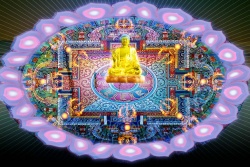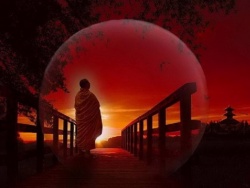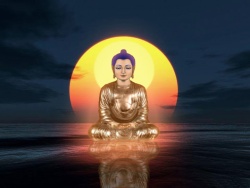The OM Mantra and the Seven Levels of Consciousness
In esoteric practices, however, the word ‘kuan’ refers to an act of immersing oneself in a physical and mental state so as to achieve contemplated reality. The practitioner puts himself in real life situations to carry out such an acts of contemplation according to esoterics. Thus esoteric Buddhism emphasizes ‘kuan’, both in action and at rest.
Moreover, in esoteric practices, special emphases are placed on the arrangement of the altar and use of mandalas. The four main classes of mandalas used in esoteric practices are (1) the maha-mandalas, representing the Buddha statue or image, (2) the Dharma or seed mandalas, representing the seed syllables of the mantras as embodiment of sutra texts, (3) the samaya mandalas, representing the instruments and mudras used in the ceremonial practices, and (4) karma mandalas, representing the descriptions or expressions of actions and accomplishments of of the Buddha having the function of cause and effect. All of such mandalas are used in association with mudras, mantras, and Dharma texts, forming the ‘Triple Dharma Seals of the True Reality, ‘ ‘the One who has no second,’ ‘the Absolute Reality’ through the union of the ‘Three Vajras’ of body, speech, and mind. A practitioner is thus able to enter the state of the Dharmakaya.
The OM Mantra and Mandukya Upanishad: Yoga Vedanta Meditation
A Transcript Study of the Teachings of Swami Jnaneshvara Bharati on the OM Mantra
OM Mantra and the Seven Levels of Consciousness
The pinnacle of the wisdom of the ancient and practices of the ancient sages of yoga is contained in the terse 12 Verses of the Mandukya Upanishad, which outlines the philosophy and practices of the OM, It has been said that the juice of the Vedas is in the Upanishads, and the juice of the Upanishads is in the Mandukya Upanishad.
OM mantra is also suggested as a direct grab to Samadhi in the yoga sutras. The teachings of the Mandukya Upanishad are well worth deep study, discussion, reflection and contemplation. By faithfully and intently engaging these 12 verses, all of the other written and oral teachings can be explored as the foundation principles and practices encapsulated in this succinct summary. It is not only the most insightful writing, but also a complete outline for Sadhana enlightenment practices.
The OM mantra is the road map of the entire process of Sadhana and the most practical tool for self-realization. One of the other hundred plus Upanishads, the Mukti (or Liberation) Upanishad, explains that for those who are seeking Liberation, the understanding and practicing of the principles of the Mandukya Upanishad is sufficient for attaining that realization.
Verses 1 to 2 describe the Self and the Absolute. Verses 3-7 explain the four-levels of consciousness. Verses 8-12 outline the four aspects of AUM mantra. Briefly the 12 Verses are: 1. All is OM; 2. Self – Atman – Brahman; 3. Waking state – Vaishvanara; 4. Dreaming – Taijasa; 5. Deep Sleep – Prajna; 6. Experiencer of the three; 7. Fourth state – Turiya; 8. A, U, and M of OM mantra; 9. A of AUM; 10. U of AUM; 11. M of AUM; 12 Silence after AUM.
Verses 1-2 are about the Self and the Absolute.
Verse 1: All is OM. The whole universe is the syllable OM/AUM. Following is the exposition of OM. Everything that was, is, or will be is in truth OM. All else which transcends time, space, and causation is also OM.
Verse 2: Atman has 4 aspects. 1) Gross | Physical Plane; 2) Subtle | Astral Plane; 3) Causal Plane/Source; 4) Fourth/Consciousness. All of these, everywhere is in truth Brahman, the Absolute Reality. Verse 2: The Individual Self itself (Atman) is also Brahman (the Absolute Reality) This Atman or Self has4 aspects through which it operates.
Verses 3-7 are on the four levels of consciousness.
Verse 3: First is Waking or Gross – the first aspect of Atman is the Self in the waking state/Vaishvanara. In this state, consciousness is turned outward to the external world. Through its 7 instruments and 19 channels, it experiences the gross objects of the phenomenal world. Briefly those 7 instrument are Space, Air, Fire, Water, and Earth, along with the Individuation from the whole, and the flow of Energy. The individual operates the 19 channels (as explained in Verse 2), which are the 4 functions of mind: Manas (sensory, processing mind), Chitta (storage of impressions), Ahamkara (I-maker or ego), and Buddhi (intelligence; knows, decides, judges, discriminates). These four functions operate through 5 Pranas: 1) Prana (heart, vitalizing, inhaling); Apana (base of torso, eliminating); Samana (naval, digestion, discernment); Udana (throat; exhalation); Vyana (whole body; coordinate systems). The 5 active senses or Indriyas, Karmendriyas of eliminating, procreating, moving, grasping, and speaking, and the 5 cognitive senses or Jnanendriyas of smelling, tasting, seeing, touching and hearing.
Verse 4: The second aspect of Atman is the Self in a Dreaming state/Taijasa. In the second state, consciousness is turned towards the inner world. It also operates through 7 instruments and 19 channels, which engage the subtle objects of the mental realm.
Verse 5: Third state is Deep Sleep/Causal/Prajna. The third aspect of Atman is the Self operating in the Deep Sleep state. In this third state, there is neither the desire for any growth or subtle object, nor any dream sequences. In Deep Sleep, all such experiences have receded or merged into the ground of undifferentiated consciousness. Here one is filled with the experience of Bliss, and can also find the way to clearer knowledge of the 2 preceding stage.
Verse 6: Find the Experiencer, the one who experiences all of these states of consciousness is the omniscient, in-dwelling source, and director of all. This one is the womb out of which all of the other emerges, all things originate from, and dissolve back into this source.
Verse 7: The fourth aspect of Atman or Self is Turiya, literally the 4th. In this 4th state, consciousness is neither turned outward, nor inward, nor is it both outward and inward. It is beyond both cognition and the absence of cognition. This 4th state of Turiya cannot be experienced through the senses, or known by comparison, deductive reason, or inference. It is indescribable, incomprehensible, and unthinkable with the mind. This is Pure Consciousness itself. This is the Real Self (Atman). It is within the cessation of all phenomena. It is serene, tranquil, filled with Bliss, and is One without a second. This is the Real or True Self that is to be Realized.
Verses 8-12 are the 4 aspects of AUM.
Verse 8: Those 4 levels of consciousness are the same, with the A, U, M, and Silence. The OM, though described as having 4 states, is indivisible. It is Pure Consciousness itself. That Consciousness is OM. The 3 sound A, U, M, and the 3 letter A, U, M, are identical with the 3 states of waking, dreaming, and sleeping, and these states are identical with the 3 sounds and letters. The 4th state, Turiya, is only to be Realized in the Silence behind, or beyond the other 3.
Verse 9: The sound A is waking/gross. Vaishvanara is the consciousness experienced during the waking state, and is “A” sound, or A, the 1st letter of AUM. That simple sound of A first and permeates all other sounds. One who is aware this level of reality has fulfillment of all longings and is successful.
Verse 10: The sound “U” is dreaming, subtle. Taijasa is the consciousness experienced during the dreaming state, and is “U”, the 2nd letter of AUM. This intermediate state operates between the waking and sleeping state, reflecting some qualities of the other 2. One who knows this subtler state is superior to others, for one who knows this, knowers of Brahman, the Absolute Reality, will be born into his or her family.
Verse 11: The sound “M” is deep sleep/causal. Prajna is the consciousness experienced during the state of dreamless deep sleep, and is “M”, or M, the 3rd letter of AUM. It contains the other 2, and is that from which the other 2 emerge, and into which they recede, or merge. A knower of this more subtle state can understand all that is within himself or herself.
Verse 12: The Silence after the AUM is the True Self/Soundless. The 4th aspect is the Soundless aspect of AUM. It is not utterable, and is not comprehended through the senses, or by the mind. Withe cessation of all phenomena, even of Bliss, this Soundless aspect becomes known. It is the state of Non-duality (Advaita) Reality, One without a second. This 4th state, Turiya, is the Real Self, or True Self. One with direct experience of this extends to Universal Consciousness. OM… OM… OM… OM…OM… OM… OM… OM… OM… OM… OM.
A Transcript Study of the Teachings of Swami Jnaneshvara Bharati on the OM Mantra
Read Further on OM Mantra and Seven Levels of Consciousness
V. M. Sakya Longyen




